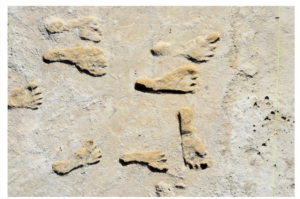Two lines in evidence support the 21,000 to 23,000 year age of for ancient footprints found New Mexico.

When humans first populated North America and how they arrived has long been a matter of spirited debate. A recent study detailing what archeologists believe are the oldest known footprints in the United States is sparking new questions and upending long-held beliefs. Stephanie Sy reports. Within the sprawling expanse of gypsum sand dunes in dry and dry lake beds in New Mexico’s White Sands National Park, researchers have spent years examining ancient footprints.
A study published in September 2021 in Science said the oldest known human footprints in North America had been discovered at White Sands National Park in New Mexico. Researchers identified about 60 fossilized footprints buried in layers of gypsum soil on a large playa in the Tularosa Basin. By carbon dating seeds embedded in the footprints, the U.S. Geological Survey estimated the prints were up to 23,000 years old. The study proposed humans could have crossed from Asia into the Americas through land connecting what is now Russia and Alaska, during the last ice age.
This discovery upset other archeological theories of how human beings came to populate the American continent, and how long ago. The reported age of the footprints challenges the once-conventional wisdom that humans didn’t reach the Americas until a few thousand years before rising sea levels covered the Bering land bridge between Russia and Alaska about 15,000 years ago.
The most recent recent research, two years later, from the scientists from the 2021 study said their methodology and findings were valid, which they say verifies that humans were indeed present in North America 23,000 years ago. The new study undertook multiple independent age estimates of the White Sands footprints, which all supported their previous study’s claims. “We always knew that we would have to independently evaluate the accuracy of our ages to convince the archaeological community that the peopling of the Americas occurred far earlier than traditionally thought,” said Jeff Pigati, a research geologist with the U.S. Geological Survey.
According to the new study, with three separate lines of evidence – involving samples of pollen grains and two different sediments – pointing to the same approximate age, “it is highly unlikely that they are all incorrect or biased and, taken together, provide strong support for the 21,000 to 23,000-year age range for the footprints.”
“It didn’t bother me at first, but it’s starting to really nudge at me, I guess you could say,” said Pasqual-Charlie, of the Pueblo of Acoma. “How much more evidence do you need to say: We did exist back then. We’ve been in the Southwest region for a very long time.”
